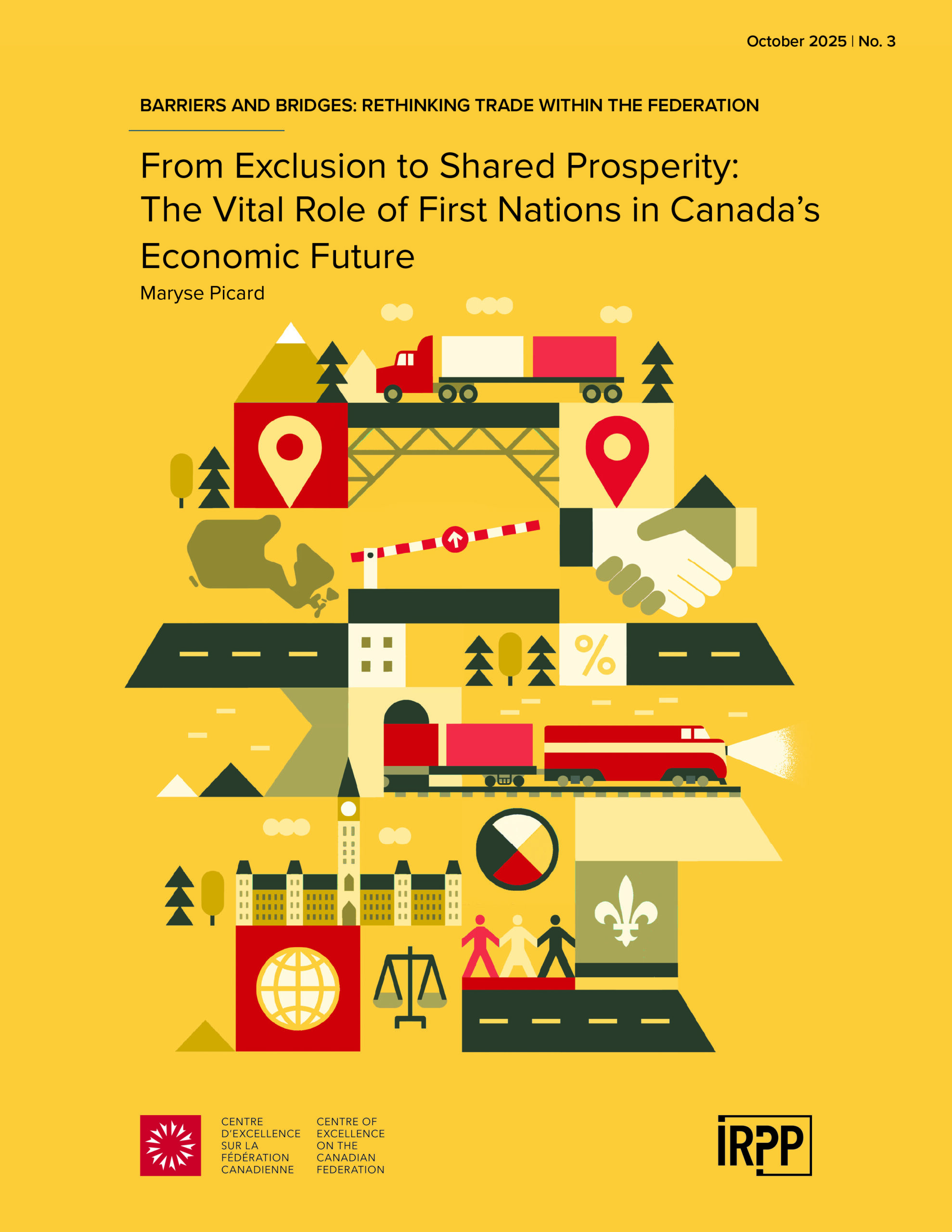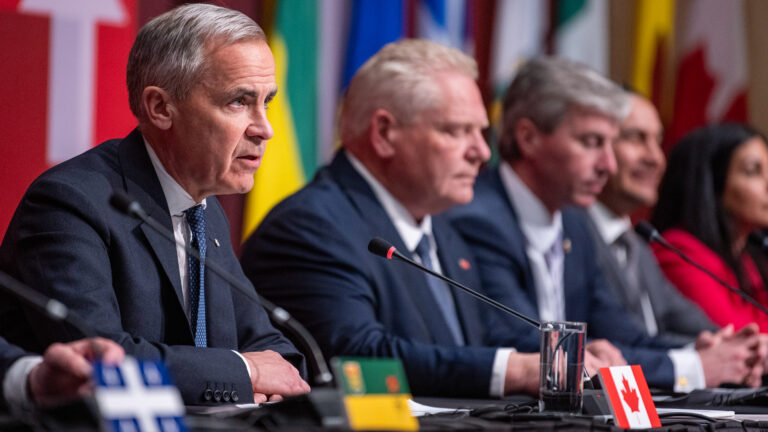From Exclusion to Shared Prosperity: The Vital Role of First Nations in Canada’s Economic Future
Introduction
In 2025, Canada faces a series of economic disruptions. U.S. President Donald Trump’s unilateral decision to impose tariffs served as a stark reminder of our economy’s vulnerability to the vagaries of international politics. This shock, and the lessons of the COVID-19 pandemic, are forcing us to rethink how we do things, increase our autonomy and build a more resilient economy that is less dependent on external partners.
In response to these challenges, provincial and territorial governments have set about reducing interprovincial trade barriers and developing alliances to create a stronger domestic market. However, one voice is too often excluded from these discussions: that of the First Nations. Yet their economic contribution, know-how, demographic weight and vision of sustainable development are strategic assets for the country’s future.
Recognizing First Nations as full partners is not an option but a necessity. Their history of resilience and creativity, despite the constraints imposed by colonialism and the Indian Act, demonstrates their ability to make a significant contribution to economic development. Securing the active participation of First Nations is an opportunity for Canada to transform a crisis into a springboard and build a more inclusive, equitable and, above all, more robust economic model.
This article argues that economic reconciliation between Indigenous peoples and Canadian society is a key factor for the successful development of internal trade. We will highlight the importance of recognizing First Nations for what they are: full partners in the country’s development since its founding. We will examine some persistent structural challenges and discuss the contributions Indigenous peoples have made to the country’s development — through their expertise, vision of the land and conception of sustainable development. We believe that Canada’s economic future cannot be built without the full participation of Indigenous people, which requires a transformation of economic relations based on respect, autonomy and the integration of different forms of knowledge.
From dependence to autonomy: Rethinking economic partnerships
The economic challenges confronting the country have been a top concern of Canadians, particularly since the beginning of 2025. Surprise and instability were followed by general agreement on the importance of reducing our dependence on the U.S. market and rethinking how we conduct internal trade. The goal is clear: to increase our autonomy, limit our reliance on imports and pursue efforts to increase collective wealth. The pandemic had already begun to push us in this direction by forcing us to act domestically to slow the spread of the virus while international borders were closed.
The Canadian public, along with politicians and economic analysts, is now asking how we can respond to the U.S. measures and reduce our dependence. One proposed solution is the removal of barriers to interprovincial trade. However, the Montreal Economic Institute, which has been monitoring the evolution of the Canadian Free Trade Agreement (CFTA) since 2019, has found little progress between the Agreement on Internal Trade of 1995 and the CFTA, signed in 2017. Monopolies, rules, standards, certifications and other regulations still constitute major obstacles, equivalent to an average tariff of 6.9 per cent (Statistics Canada, 2017). However, in recent months, the provinces and territories have appeared intent on swiftly reducing the number of exceptions under the CFTA.
While Canada’s premiers are forming unexpected alliances and meeting regularly to strengthen economic co-operation, defend specific provincial interests and reduce the initially agreed exceptions, none has thought to include First Nations leaders in these discussions (Carter, 2025). Yet First Nations hold in their hands some critical solutions for meeting Canadians’ needs and stimulating the economy. Like all other citizens, members of First Nations aspire to economic autonomy, a key step toward self-government and control over their destiny (Cantin, 2025). They are already taking concrete action to achieve these goals and chart their own future. Despite limited resources, many Indigenous nations are making efforts of various kinds to generate income independently. For example, in recent years, several communities in Quebec have established strategic partnerships in the renewable energy sector, largely to develop wind power projects.
The underestimated strength of First Nations
Throughout Canada’s history, the quiet strength, resilience and wisdom of First Nations have enabled them to wage multiple political, economic, territorial, cultural and linguistic battles. In their fight for equality, respect, recognition and a form of reconciliation that can eventually lead to economic autonomy, they are acting in their own interest, first and foremost, while being prepared to fight alongside Canadians when the collective interest is at stake. Indigenous communities know that the well-being of the general population directly affects that of their own members.
The strength of Indigenous nations, rooted in a combination of creativity, instinct, ancestral know-how, negotiating skills and community spirit, is evident in the creation of businesses that meet their communities’ local needs. With a younger demographic structure than non-Indigenous Canadians, Indigenous people also constitute a significant labour pool that could help alleviate the current shortage. During an interview at the Summit of First Nations and Municipalities on Reconciliation in Montreal in 2018, Ghislain Picard, then Chief of the Assembly of First Nations of Quebec and Labrador, commented: “The number one solution is immigration, and I am stunned to hear this, when in Quebec, people aged 25 and under sometimes make up 50 per cent of an [Indigenous] community. Why can’t we look there?” (Radio-Canada, 2018). With a lower labour force participation rate (57.6 per cent) than non-Indigenous Canadians (63.7 per cent) and a younger population (Institut du Québec 2021; Statistics Canada, 2025), First Nations workers would benefit from being better integrated into the labour market, which would promote reconciliation and reduce the exclusion of these populations.
In its quest for economic autonomy, Canada is thus being pushed to review its methods, develop a less import-dependent economy, process its own raw materials and encourage exports to Europe and other markets, while strengthening the spirit of mutual support within its communities. This awakening should lead the provinces and territories to fully recognize the role of Indigenous peoples and include them as key players in Canada’s new economy.
The historical contribution of First Nations obscured
Most Canadians know little about Indigenous peoples, their past and present struggles, their aspirations and values, but these could serve as an inspiration and a model for all. Unfortunately, the dominant version of Canadian history often portrays them as peoples lacking social organization, reflecting the systemic racism that has left its imprint on historical narratives.
The true story of Canada’s First Nations and their important contribution to the survival of Europeans and the development of the country over several centuries remains largely untold. Only one version of history is taught and disseminated: that of the dominant group, embellished and made harmonious. As a result, the realities of Indigenous peoples, who have suffered from colonialism and institutional racism for centuries, are obscured and rarely conveyed to non-Indigenous people transparently and accurately.
Trading relationships in the Americas date back at least 6,000 years (EDUTIC, n.d.). They were based on sharing the wealth of the land: Indigenous peoples harvested the resources of the land through hunting, fishing, gathering and farming, and offered their surpluses to other nations in exchange for objects that were rare or foreign to their own region. For example, the St. Lawrence Iroquoians, who were sedentary farmers, traded their agricultural surpluses to nomadic peoples such as the Algonquins in exchange for furs. The farther an object had travelled, the rarer and more valuable it became. Importantly, this type of barter also brought prestige and established or strengthened alliances between nations.
The contribution of Indigenous peoples to Canada’s economy, particularly in recent decades, has largely been overlooked by non-Indigenous people. Long before the arrival of Europeans, Indigenous societies had a structured system, based on long-term relations between nations, in which trade played a central role and was embedded in a democratic way of life (National Defence, 2018). First contact with Europeans, who were driven by an insatiable appetite for furs from northeastern North America, threw Indigenous trading rules into disarray, disrupting many peaceful arrangements and creating conflicts between nations where there had never been conflicts before. The massive demand for fur by the French and then, after the Seven Years’ War, by British and American companies, also led to the overexploitation of beaver, a unique resource, contrary to the principle of preserving and living in harmony with wildlife that was so important to Indigenous peoples.
Economic exchanges between Indigenous peoples and the newcomers gradually altered the once diplomatic and respectful relations between Indigenous nations, replacing them with tensions fuelled by the quest for power and the use of force. This dynamic weakened the economic and social vitality of Indigenous peoples, creating a widening gap between the communities. Over the past two decades, the Canadian government has taken steps toward reconciliation, including the Truth and Reconciliation Commission, but the rift remains, with Indigenous peoples still largely marginalized in contemporary historical narratives.
Today, the economic growth of First Nations and all the efforts they and governments have made in recent years to strengthen their economy run up against a formidable enemy: the Indian Act. While it is not considered a genocidal law, its intent was to assimilate First Nations through the destruction of their culture (Canadian Encyclopedia, 2022; Canadian Historical Association, n.d.). It is still in force, despite the adoption of the United Nations Declaration on the Rights of Indigenous Peoples Act (SC 2021, c 14; UNDRIP), which asserts the importance of federal recognition of Indigenous nations’ right to self-determination but makes no reference to the Indian Act, which is a major obstacle to implementation of UNDRIP. Among other things, the Indian Act grants the Minister greater powers than the band councils, limiting their decision-making autonomy.
The Indian Act: Analysis of its historical and contemporary impacts on trade
The Indian Act is one of the most central — and controversial — pieces of legislation in the history of Canada’s relations with First Nations. Adopted in a colonial setting, it has profoundly influenced the social, economic and cultural dynamics of Indigenous peoples in Canada. Its original objective was certainly not to recognize or value Indigenous cultures, but at best to assimilate them into the values, culture and norms of the dominant society, and at worst to simply expunge Indigenous cultures from society. Examining the origins, effects and evolution of this Act will shed light on the efforts of Indigenous communities to build resilience and revitalize their cultures.
Under the Constitution Act, 1867 (30 & 31 Victoria, c. 3 [U.K.]), the federal Parliament was granted legislative jurisdiction over “Indians, and the Lands reserved for the Indians.” It was within this framework that Parliament passed the first Indian Act in 1876.
In 1884, the Canadian Parliament reinforced the policy of assimilation by amending the Act to prohibit the potlatch, a ceremony that was vitally important for the exchange and redistribution of wealth. This centuries-old practice served not only to regulate trade but also to define social status, land rights and political responsibilities within clans. Banning it had a profound impact on the political and economic structures of First Nations, depriving them of their traditional mechanisms of social organization and exchange between nations.
By establishing reserves on which Indigenous peoples were to be settled, the Canadian government stripped them of their commercial practices and cultural traditions, and isolated them from urban centres. Indigenous peoples were gradually excluded from the country’s economic development and became dependent on the Canadian state (Public Inquiry Commission, 2019).
While it is still in force today, the Indian Act was amended in 1951 to remove the sections prohibiting cultural activities, allowing Indigenous peoples to gradually reclaim their ancestral and traditional knowledge. Non-Indigenous interest in Indigenous art and culture, and the benefits of learning and sharing Indigenous knowledge of hunting and fishing, led to the development of a tourism industry in more remote regions and sparked the beginnings of economic recovery in some communities (Iankova, 2011).
A prime example of this resilience is the establishment of Air Inuit in 1978. Nearly 50 years later, it is still active, serving the 14 villages of Nunavik (northern Quebec) with air links to Montreal, Quebec City and Sept-Îles. As of 2025, Air Inuit operates 35 aircraft and employs more than 200 pilots, approximately 10 per cent of whom are of Inuit origin (Bélanger, 2025). In addition to carrying passengers, the airline plays a crucial role in food supply, public safety, prisoner transport and the operation of the circuit court in northern communities.
Economic evolution of First Nations, development prospects and the obstacles created by the Indian Act
Despite examples of business success, First Nations economic development is still hampered by the constraints imposed by the Indian Act. Although some provisions have been relaxed over the decades, a number of discriminatory provisions remain in force, stifling the entrepreneurial spirit of First Nations people, particularly those living on reserves.
Upon its enactment, the Indian Act reduced First Nations people to the status of “wards of the state.”[1] Communities were deprived of fundamental rights, relocated and forced to crowd into small territories far from economic centres. These territories, called reserves, hemmed them in and prevented them from practising their traditional subsistence activities, moving freely across the rest of the territory and maintaining their trade networks. This quickly led to famines and the loss of many lives.
The reserves are governed by the Indian Act to this day: the land belongs to the federal Crown and is set aside “for the use and benefit” of an Indian band. This system of forced collective ownership prevents individuals from achieving full economic autonomy:
- Band councils must prioritize the housing needs of families, reducing the space available for commercial activities on their land;
- Even when land is designated for economic use, it remains Crown property; a businessperson cannot use it as collateral for a loan;
- Non-Indigenous businesses cannot set up on reserves, as the land must be used exclusively for the benefit of the band or its members.
In addition to these obstacles, paragraph 89(1) of the Act prohibits the seizure of real or personal property belonging to an Indigenous person located on a reserve. Presented as a protection, this provision has the effect of excluding Indigenous people from traditional credit mechanisms. Without the ability to provide collateral, it is virtually impossible for them to obtain a loan or attract investors.
Thus, the Indian Act not only destroyed the traditional economic systems of First Nations when it was passed but still continues to deprive their members of the financial and landed property instruments necessary for their autonomy. This system perpetuates deep inequalities of which the general public is still too often unaware.
Economy in transition: The role of Indigenous businesses
Constrained by law but guided by community values of mutual aid, Indigenous businesses were initially geared to meeting local needs. They included shops, gas stations, hotels, tourism services, construction and community-based enterprises.
Over the past few decades, this entrepreneurial landscape has diversified and grown stronger. Indigenous businesses are now present in industries as varied as mining, transportation, aviation, professional services, casinos, real estate, cannabis cultivation and large hotel complexes.
Often located in remote areas, these businesses primarily serve the needs of their own communities, addressing the “economic deserts” found on reserves by providing basic services. The isolation of Indigenous villages, which complicates the supply of goods and services, also fuels the entrepreneurial spirit, particularly in the form of self-employment, which is growing steadily among First Nations, Métis and Inuit people (National Indigenous Economic Development Board, 2024).
The size and diversity of Indigenous businesses are greater than commonly believed. Annual operations represent billions of dollars, employ thousands of people, and have a growth rate linked to the increase in their business revenues, which are among the highest in the country. (Bélanger Baur, 2019). Many small and medium-sized enterprises (SMEs) in service sectors such as food, transportation, maintenance, snow removal, accommodation and restaurants provide essential employment opportunities in their communities, as well as supporting the operations of large multinationals that exploit natural resources in the surrounding areas.
Indigenous businesses are particularly prominent in the arts, entertainment and culture industries. APTN, the first national Indigenous broadcaster, was launched in 1999 and is now a global leader. Its success illustrates the creative vitality of Indigenous entrepreneurship.
Although Indigenous people account for only 5 per cent of Canada’s population, their approximately 50,000 businesses generate nearly $49 billion annually (Daly, 2023). However, they are a minority in an economy dominated by non-Indigenous businesses (Canadian Council for Indigenous Business, 2025; Statistics Canada, 2022).
Indigenous SMEs export less than others — only 7.2 per cent of their output compared with 12.1 per cent for non-Indigenous businesses (Canadian Council for Aboriginal Business & Global Affairs Canada, 2023). Distance is one of the main factors that account for this gap. Businesses based in remote areas are 65 per cent less likely to export (Office of the Chief Economist, 2025). Fortunately, the expansion of e-commerce has increased export opportunities sixfold. While the United States was the preferred market prior to the election of President Donald Trump, Indigenous businesses have naturally formed partnerships with Indigenous businesses in Australia and New Zealand, given their special relationships with the Indigenous peoples of the Pacific (Government of Canada, 2024).
It should be noted that Indigenous SMEs outperform Canadian SMEs in revenue and growth (National Indigenous Economic Development Board, 2024). However, Canada’s economy is dominated by non-Indigenous businesses, which account for 98.68 per cent of private enterprises. There are no signs of this gap narrowing at present, but First Nations are well positioned to do more.
“CCAB’s research shows that Indigenous entrepreneurs are motivated by a desire to innovate, expand and profit from their businesses, with many giving back to their communities. However, they also face unique challenges to their growth and development” (Canadian Council for Aboriginal Business & Global Affairs Canada, 2023, p. 5).
To be sure, the federal and provincial governments have established assistance programs that provide loan guarantees or grants to support the entrepreneurial spirit of First Nations people. However, these programs are scattered across different departments, agencies and levels of government, and are not well known among the potential beneficiaries. There are often criteria that exclude specific industries or regions, including the North. Better access to government tenders for Indigenous businesses — for example through a scoring system that favours Indigenous enterprises — would allow them to grow and participate more fully in the Canadian economy.
While it may seem that everything is in place for First Nations to participate fully in Canada’s economic development, this impression is misleading: many structural barriers remain and still prevent them from achieving their potential. Governments and non-Indigenous businesses must both make more sustained efforts.
Already engaged in their own economic development, and thereby contributing to that of all Canadians, Indigenous peoples are motivated to participate in the collective effort to build a more inclusive and prosperous Canada.
Canada must fulfil its constitutional obligations
To promote the economic development of First Nations and enable them to participate in the Canadian economy, it is imperative that governments and large corporations recognize their existence and strength, and take first steps toward partnering with Indigenous businesses.
These first steps aren’t an option; they are a constitutional obligation. Chapter 8 of the Canadian Free Trade Agreement provides that, notwithstanding measures taken to eliminate internal trade barriers, the parties must fulfil their obligations under their treaties with Indigenous peoples, including land claim agreements (CFTA, 2017).
The obligation to consult does not apply only under the CFTA. It has been upheld by decades of judgments that engage the honour of the Crown, a constitutional principle that requires governments to act with honour in their dealings with Indigenous peoples. Case law holds that the extent of the required consultation depends on the severity of the potential adverse impact on rights or title.
It is important to remind the country’s political and business leaders that they must fulfil their obligations to Indigenous peoples by involving them in major projects as of now. To achieve this, governments must build long-term trust while promoting the economic, social and cultural development of First Nations in a manner that respects their right to self-determination.
It must be noted that the evolving nature of the law and developments in case law in recent years do not suggest that there can be exceptions to the obligation to conduct meaningful, organized consultations that respect Indigenous values and expertise, whether or not we are in a time of crisis or a trade war.
Economic development and Indigenous rights: A fraught equation
In recent years, there has been an upsurge of protest by First Nations leaders concerning inadequate implementation of the constitutional obligations to respect ancestral and treaty rights. The Free Trade and Labour Mobility in Canada Act and the Building Canada Act are arousing serious concern among Indigenous leaders.
The opposition stems mainly from the federal government’s desire to accelerate infrastructure projects, often at the expense of its obligation to consult and to respect protected rights. Too often, First Nations are consulted only at the very end of the decision-making process, leading to legal actions and unresolved tensions.
Beyond the legal issues, Indigenous peoples also have environmental and intergenerational concerns. While First Nations want to participate actively in the country’s economic development, they refuse to do so at the cost of the degradation of their land. They regard financial autonomy as inseparable from self-government. However, when a choice must be made between economic growth and preserving the land, the latter wins out, because protecting the land for future generations is a value deeply rooted in their world view.
Conclusion
This historical backdrop and its past and present ramifications, which are indicative of the unequal relationship between colonialist federal and provincial governments and Indigenous peoples, must be borne in mind.
Economic reconciliation is important for fostering relationships of mutual respect between our societies, and between governments and Indigenous peoples.
The multifactorial nature of the challenges demands a plurality of solutions. No one measure can adequately address all the constitutional and legislative issues, and the persistent discrimination against First Nations people.
Today, Indigenous peoples are prominent by their absence from many debates and decisions. The discussions about interprovincial trade are no exception. Yet the role of Indigenous communities in Canada’s history, their expertise, their knowledge of the land and their labour power make them a key force for the country’s economic future. At a time when labour has become a scarce and precious resource, their participation represents not only a solution but above all an opportunity to build a stronger and more equitable society.
To achieve this, it is essential to move away from the current model, too often based on government programs imposed from above. First Nations are clearly expressing their desire to break free of this dependence and pursue autonomous economic development, driven by their own needs, priorities and vision. In other words, it is no longer a matter of allowing them a seat out of obligation but of recognizing their role as full partners.
These partnerships must be established at the outset of a project. Keeping First Nations in the dark or involving them once the decisions have already been made and the projects are set in stone is no longer enough. They must be involved from day one, when a potential project or new development and the lands that will be affected are first considered. That is the point at which their voices, expertise and priorities must be incorporated into the process.
To make this collaboration a reality, two things are essential: better communication and more knowledge. Clear strategies must be developed to reach out to the communities, understand their realities and learn about their businesses and the services they offer. Data on Indigenous products and services should also be centralized so that decision-makers and government officials can use this information to develop their programs, starting not from administrative considerations but from the intentions and priorities of First Nations.
In short, Canada’s economic future cannot be built without Indigenous peoples. The benefits are many and will accrue to everyone. First Nations can contribute to the economy through their labour power, their businesses and services, their detailed knowledge of the land, their vision of sustainable development and their ability to design alternative models.
Recognizing their place, valuing their contribution and creating genuine partnerships based on their needs and vision is not only a way to repair the long history of exclusion but also an opportunity to build a stronger, more inclusive and more sustainable country.
As Senator Paul Prosper put it, “To buy Indigenous is to buy Canadian.”
NOTE
[1] In Canadian law, “wards of the state” has historically been the status assigned to Indigenous people who qualify as Indians under the Indian Act. While the term does not appear in the Act itself, there is a wealth of legal and historical literature explaining that Parliament’s true objective in passing the Act was to keep Indigenous people under the guardianship of the federal government by imposing various legal incapacities on them and legally enshrining their economic dependence on the state (Canadian Encyclopedia, 2017).
REFERENCES
Bélanger Baur, A. A. (2019). Indigenous-owned exporting small and medium enterprises in Canada. Office of the Chief Economist of Global Affairs Canada & the Canadian Council for Aboriginal Business. https://www.international.gc.ca/trade-commerce/assets/pdfs/indigenous_sme-pme_autochtones-eng.pdf
Bélanger, J-F. (2025, June 21). Former des pilotes inuit pour servir le Nunavik. Radio-Canada
https://ici.radio-canada.ca/recit-numerique/13228/inuit-pilote-formation-nord
Canadian Council for Aboriginal Business & Global Affairs Canada. (2023). Adàwe. Export experiences of Indigenous entrepreneurs. https://www.ccib.ca/wp-content/uploads/2023/10/ccab_report_english_FINAL.pdf
Canadian Council for Indigenous Business. (2025). CCAB research. Industry focus.
https://www.ccib.ca/research/publications/industry-focus/
Canadian Encyclopedia. (2017). Treaties with Indigenous peoples in Canada. Canadian Encyclopedia. https://thecanadianencyclopedia.ca/en/article/aboriginal-treaties
Canadian Encyclopedia. (2022). Indian Act. Canadian Encyclopedia.
https://thecanadianencyclopedia.ca/en/article/indian-act
Canadian Free Trade Agreement. (2017). The Canadian Free Trade Agreement.
https://www.cfta-alec.ca
Canadian Historical Association. (n.d.). The history of violence against Indigenous peoples fully warrants the use of the word “genocide.” https://cha-shc.ca/the-history-of-violence-against-indigenous-peoples-fully-warrants-the-use-of-the-word-genocide/
Cantin, G. (2025, February 1). Des Premières Nations en route vers l’autonomie économique. Le Soleil. https://www.lesoleil.com/actualites/actualites-locales/2025/02/01/des-premieres-nations-en-route-vers-lautonomie-economique-HDSLDTJMMZEIXOVTLRUEPNNIA4/
Carter, O. (2025). Canada premiers trade meeting 2024: Leaders unite to counter U.S. tariffs. CO24. https://co24.ca/canada-trade-meeting-2024/
Daly, Jane. (2023, July 31). Building trust with Indigenous businesses. Export Development Canada. https://www.edc.ca/en/article/building-relationships-with-indigenous-businesses.html
EDUTIC. (n.d.). Commerce entre les nations. Université du Québec à Trois-Rivières.
https://oraprdnt.uqtr.uquebec.ca/portail/gscw031?owa_no_site=85&owa_no_fiche=141
Government of Canada. (2024). Canadian Indigenous trade delegation strengthens ties with Australia and New Zealand. https://www.international.gc.ca/world-monde/stories-histoires/2024/indigenous-trade-delegation-commerciale-autochtone.aspx?lang=eng
Iankova, K. (2011). Le tourisme autochtone au Québec. Globe, 8(1), 85-98.
https://www.erudit.org/fr/revues/globe/2005-v8-n1-globe1498830/1000896ar/
Institut du Québec. (2021). Mise à jour économique du gouvernement du Québec. Rareté de main-d’oeuvre au Québec. Plan d’action pour transformer les déséquilibres en opportunités. https://institutduquebec.ca/wp-content/uploads/2021/11/202111-IDQ-Plan-daction.pdf
National Defence. (2018). The arrival of the Europeans: 17th century wars. Government of Canada. https://www.canada.ca/en/department-national-defence/services/military-history/history-heritage/popular-books/aboriginal-people-canadian-military/arrival-europeans-17th-century-wars.html
National Indigenous Economic Development Board. (2024). The Indigenous economic progress report. https://www.niedb-cndea.ca/wp-content/uploads/2024/12/Indigenous_economic_progress_report_2024_EN.pdf
Office of the Chief Economist. (2025). Canada’s state of trade 2025: Small and medium enterprises taking on the export challenge. Government of Canada. https://international.canada.ca/en/global-affairs/corporate/reports/chief-economist/state-trade/2025
Public Inquiry Commission on Relations between Indigenous Peoples and Certain Public Services in Québec: Listening, Reconciliation and Progress (Viens Commission). (2019). Testimony of Maryse Picard. Exhibit P-39. Gouvernement du Québec. https://web.archive.org/web/20240117195216/https://www.cerp.gouv.qc.ca/index.php?id=2&L=1
Radio-Canada. (2018, August 30). Les Autochtones, une solution à la pénurie de main-d’œuvre, soutient Ghislain Picard. https://ici.radio-canada.ca/nouvelle/1121046/emploi-autochtones-solution-penurie-main-oeuvre-travailleurs
Statistics Canada. (2017, September 14). Study: Estimating the effect of provincial borders on trade. The Daily. September 14. Government of Canada. https://www150.statcan.gc.ca/n1/daily-quotidien/170914/dq170914d-eng.htm
Statistics Canada. (2022, September 21). Indigenous population continues to grow and is much younger than the non-Indigenous population, although the pace of growth has slowed. The Daily. September 21. Government of Canada. https://www150.statcan.gc.ca/n1/daily-quotidien/220921/dq220921a-eng.htm?indid=32990-1&indgeo=0
Statistics Canada. (2025). Labour force characteristics by region and detailed Indigenous group, inactive. Table 14-10-0365-01. Government of Canada. https://www150.statcan.gc.ca/t1/tbl1/en/tv.action?pid=1410036501&request_locale=en
Maryse Picard’s essay highlights the limited space given to Indigenous communities in discussions surrounding trade in Canada, despite the diversity of stakeholders at the table. She argues that internal trade in Canada can only succeed if it truly includes Indigenous communities. She recalls the harmful effects of colonization and the constraints imposed by the Indian Act on Indigenous peoples’ opportunities to trade. A serious discussion of interprovincial trade can only be had by addressing First Nations and Inuit economic development. Picard argues that interprovincial trade must not ignore Canada’s constitutional obligations to Indigenous communities. Any discussion of trade within the federation must take all stakeholders into account.
This essay was published as part of the series Barriers and Bridges: Rethinking Trade Within the Federation published under the direction of Valérie Lapointe by the Centre of Excellence on the Canadian Federation. Editorial co-ordination was done by Étienne Tremblay, proofreading by Zofia Laubitz and production and layout by Chantal Létourneau and Anne Tremblay.
This essay was translated from French by John Detre. It is also available in French under its original title De l’exclusion à la prospérité partagée : le rôle incontournable des Premières Nations pour l’avenir économique du Canada.
Maryse Picard is a lawyer at Delegatus. She previously served as Executive Director of the Huron-Wendat Nation from 2021 to 2025 and was Chief of Staff to the Minister of Indigenous Affairs from 2018 to 2021, the first Indigenous woman to hold this position. Ms. Picard has a long track record in the Quebec public service. During her career, she has participated in two national commissions of inquiry; the first, as an expert, focused on relations between Indigenous peoples and certain public services in Quebec, and the second, as a lawyer, focused on murdered and missing Indigenous women and girls.
To cite this document:
Picard, M. (2025). From Exclusion to Shared Prosperity: The Vital Role of First Nations in Canada’s Economic Future. Institute for Research on Public Policy.
The opinions expressed in this essay are those of the author and do not necessarily reflect the views of the IRPP or its Board of Directors.
If you have questions about our publications, please contact irpp@irpp.org. If you would like to subscribe to our newsletter, IRPP News, please go to our website at irpp.org.
Cover: Luc Melanson








